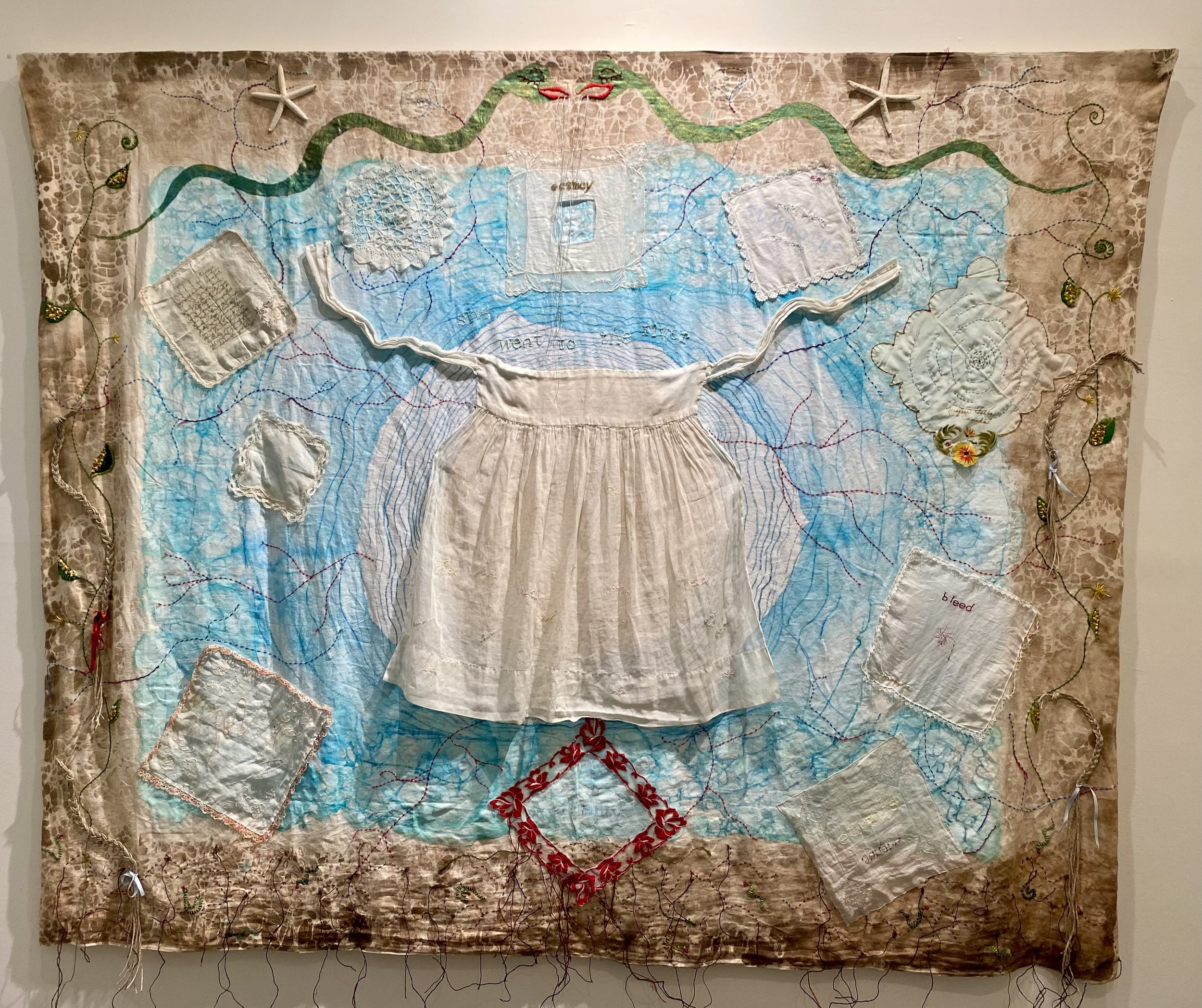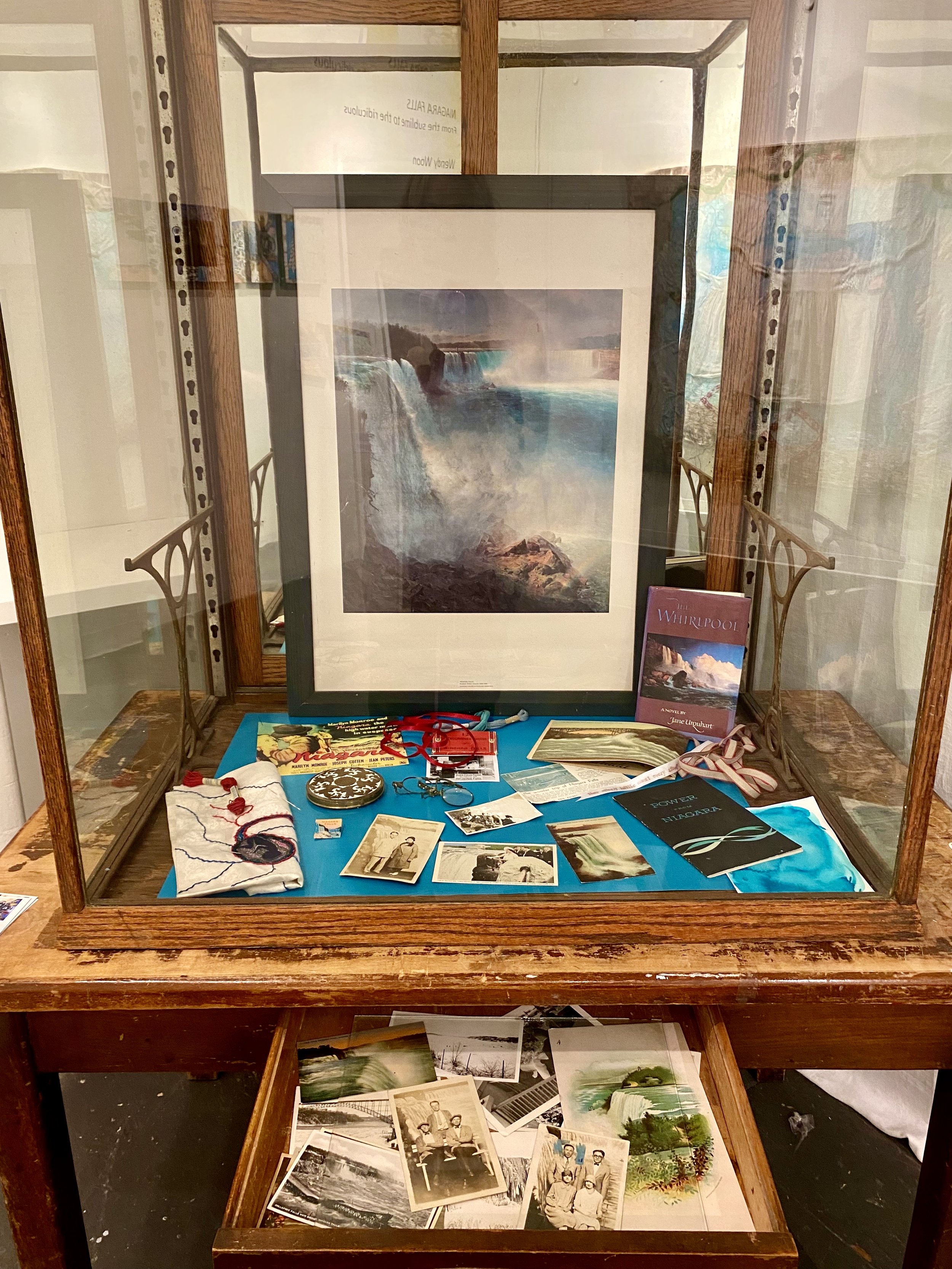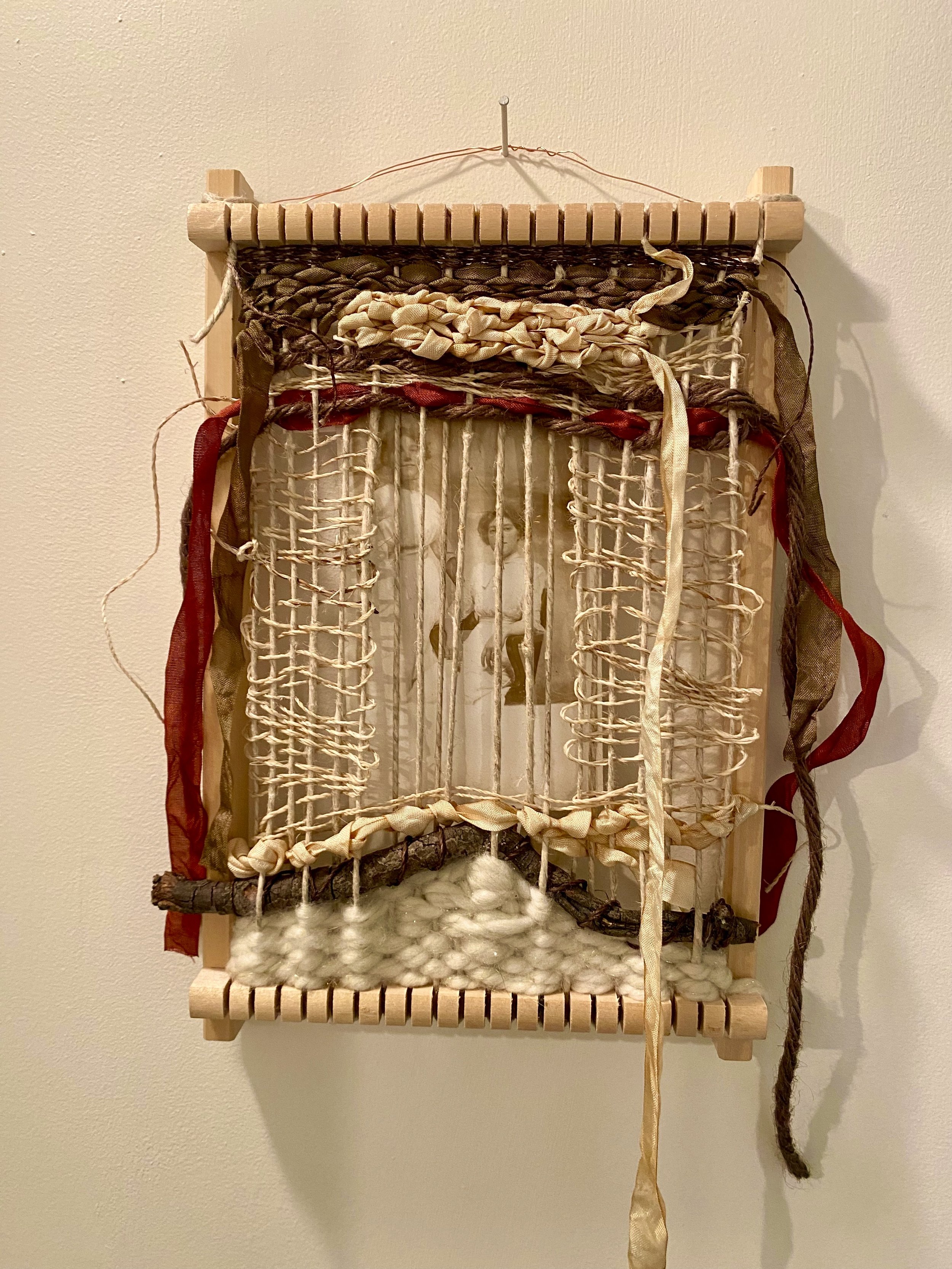“To focus on place allows us to bring in the small details around the conditions and materials of working, too often lost to the archive, that help uncover why anything even gets made.”
Prudence Peiffer, The Slip, pg. xv
Niagara Falls - From the Sublime to the Ridiculous, Chapter 2 in-progress, 2024
The following works from 2024 continue to expand upon my interest in exploring aspects of Niagara Falls, a cultural and environmental phenomenon that shaped me. Five generations of my family, settlers, resided in the Niagara region. According to oral tradition and archeology, the land along the Niagara River has been inhabited by indigenous people for over 13,000 years. It is recognized as a spiritual place with rich ties to indigenous history and culture for generations. My family’s story is but a drop in the flow of time.
Niagara Falls acts as a framework for my work, exploring environmental, social, technological, and cultural themes that are personal yet connected to more significant paradoxes about where we find ourselves as a species today. These works begin a new chapter in my 20-year Niagara project, building on my exhibition at Footnote Project Space, Niagara Falls: From the Sublime to the Ridiculous, October - December 2023. This selection of work critically explores themes of water, power, gender, and cultural norms around the body and the environment. The drawings are a research process for larger pieces. I will continue with and expand upon these themes as I continue in this next chapter, 2025, in new moving images.
Alternating Current, 2024
Alternating Current, 2024, gesso, conte, watercolor, pastel on paper, 48” x 131”
A meditation on power and the role of Niagara Falls in developing electric energy in the late 19th century and its role in catalyzing the transformation from steam to electric power, amplifying rapid industrial development in Niagara and beyond. The story of the bitter feud between Edison and his direct current model (backed by Westinghouse) and Tesla, who pioneered alternating current, allowing electricity to travel far distances, seems resonant in our current climate of fear and misinformation. Desire, power, balance, and vision are all themes I associate with Niagara Falls, and how natural resources, like water, can be considered a community resource or a commodity for generating wealth are ongoing questions for contemplation.
The Power of Niagara, 2024
The Power of Niagara, 2024, Mixed media, collage, gesso, acrylic, and watercolor on wood panel, 24” x 30”
Niagara Falls is a powerful natural landscape for many reasons. In addition to its visual and metaphoric power, it generates one-quarter of all energy used in New York State and Ontario, and generating stations on the US and Canadian sides form the largest generators of hydroelectric power in North America. Two books sparked my interest in the history of the development of hydroelectric power generation at Niagara Falls, Niagara Power: History of the Niagara Falls Power Company, 1886-1910, volume 1, (Edward Dean Adams) and City of Light (Lauren Belfer.) In particular, I was interested in the early commodification of Niagara Falls by robber barons and captains of industry, issues around labor, workplace safety, and protecting the natural environment. Although Niagara Falls was one of North America's first environmentally protected areas, it was so because of the exploitation by settlers and capitalists. Is water a commodity for profit or a public trust in which we all share responsibility for its care?
Tinman’s Niagara, 2024
Tinman’s Niagara, 2024, Mixed media, photocopy, tin foil, gesso, conte, and watercolor on wood panels, series of three, two at 20” x 20” and 12” x 36”
A vision of nature mediated by technology. A thin line separates life and death.
La Spelterina, 2024
La Spelterina, 2024, gesso, mixed media, pencil, ink, mounted on wood panels, series of three 10” x 10” each
In my research on Niagara Falls, I’ve been fascinated by Maria Spelterini, also known as “La Spelterina.” A 23-year-old Italian tightrope walker, she made return trips across the gorge below Niagara Falls five times in 1876 with increasing challenges—blindfolded, walking backward and forward, with hands and ankles shackled, and with peach baskets on her feet, to wild public acclaim. She disappeared from public performances a few years later. She was born into a circus family and began her career at three years old. She appears to follow in the footsteps of her ancient heritage, flanked by these two tightrope walkers inspired by frescoes from Pompeii, which I found on view at the Museo Archeologico Nazionale di Napoli. Live wires and a ripple effect!
Dreaming of Highwires, 2023-4
Dreaming of highwires, 2023-4, mixed media on wood panels, series of five 9” x 12”
Detail, Dreaming of Highwires, 2024, panel 4/5
The Curse of the Whirlpool, 2024
The Curse of the Whirlpool, 2024 (work in progress), cyanotype, thread, beading on fabric, 5’ x 7”
This work is a collaboration between myself, the sun, and the Niagara River. I made this cyanotype on treated fabric on a small island I used to play on as a child, on the Niagara River, close to my home. The body imprint is mine, but it could be any woman’s. It includes visual references to women’s stories from Niagara in previous works. After it was exposed, it was rinsed in the Niagara River, a kind of ritual performed.
The Whirlpool, a novel by Jane Urquhart, has occupied my consciousness for over 30 years. It includes references to “floaters,” the unidentified bodies that go over Niagara Falls and end up downstream in the whirlpool. For the book, she drew upon her mother-in-law’s records from a family of undertakers in Niagara Falls, recording the details of the bodies and their accompanying objects.
It made me think about why and how women’s bodies were sucked into the vortex and what cultural norms, gender inequities, and restrictions led them to hopeless outcomes. Now more than ever, it seems resonant as women’s rights over their bodies are a political battleground in the United States. Women embody the most creative force that sustains our culture, yet that power is a threat.
Drawings 2024
At the Brink series, 2024
At the Brink series, 2024, ink, marker, watercolor on paper, 8” x 10” each
Sketches from the Whirlpool, 2024
Sketches from the Whirlpool, 2024, gesso and ink on paper mounted on wood panels, 12” x 12” each
Below, 2024
Below, 2024, Cyanotype on fabric, 8.25” x 10.75” each
Niagara Falls - From the Sublime to the Ridiculous, Chapter 1, 2022-3
Niagara Falls- From the Sublime to the Ridiculous is the first chapter in a twenty-year project to reflect upon the place where I was born and raised and five generations of my family were settlers. According to oral tradition and archeology, the land along the Niagara River, inhabited by indigenous people for over 13,000 years, is considered a spiritual place with rich ties to indigenous history and culture for generations. My family’s story is but a drop in the flow of time.
I grew up alongside the river, on the Canadian side, a few miles above the Falls. When my mother passed away in 2013, she was the last of our family to live and be buried in Niagara Falls. I inherited archives in the form of photographs, ephemera, textiles, and shared family stories.
This project started over 30 years ago, leading me back to my roots and a sense-making about this place and questions of identity and belonging, which occupy me at this stage of life.
Below you will find work that continues my interest in exploring aspects of Niagara Falls, a cultural and environmental phenomenon that shaped me. Five generations of my family, settlers, resided in the Niagara region. Indigenous people have inhabited the land along The Niagara River for over 13,000 years. According to oral tradition and archeology, it has been recognized as a spiritual place with rich ties to indigenous history and culture for generations. My family’s story is but a drop in the flow of time.
This body of work was exhibited at Footnote Project Space, Brooklyn, NY October 19 - December 5, 2023.
Making Something Out of Nothing, 2023
Making Something Out of Nothing, 2023, mixed media and archival family textiles, 67” x 78”
I inherited an archive of textiles from the women in my family. The base tablecloth for this piece was an unused cloth from my great aunt’s trousseau, a trove of linens collected in anticipation of marriage. Never married, it remained pristine. The centerpiece is an apron given to my mother at a wedding shower, embroidered with all of the names of the women in the family each in her own script, an object for which I sensed my college-educated mother had ambivalence.
Embroidered, embellished, and initialed handkerchiefs reminded me that textiles have histories of tears, wounds, and illnesses, ready in handbags to tend to others in need. The framing motif is the pattern of the brain while meditating, a reminder of the meditative act of tatting and embroidery. The French knots were taught to me by my great-grandmother, that knowledge is embodied within me.
“Making something out of nothing” is a dualism – a phrase that champions the resourcefulness of women to create with what is at hand – but it also evokes diminishment of women’s emotions as too expansive ...making something out of nothing. The phrase “she went to the river” was used locally to describe when a woman in Niagara decided to go to the river to end her life, a phrase I recall from childhood that I imagined was a return to the source.
Church’s Blue, 2023
Church’s Blue, 2023, vitrine with reproduction of Niagara Falls, by Frederic Edwin Church (1826-1900), National Museum of Scotland, Edinburgh, and ephemera of varied sizes.
This assemblage references the specific bluish-green of the water of Niagara as documented in this reproduction of Fredric Edwin Church’s painting (1926-1900), which is visible throughout this body of work. The ephemera handed down to me includes printed material, postcards, and promotional brochures for tourists. In addition to hydroelectric power, tourism has shaped the cultural, social, and economic life of Niagara Falls since settlers arrived. The formal and informal photographs are a reminder of the transience of memory. I hold the last memories of stories told to me that reveal the context and, in some cases, the people in these photos.
Daredevils and Stories Series, 2022
This series references the stories of Niagara’s daredevils, and the varied shapes of vessels of their own design they used to traverse the falls, not always successfully. The final piece references indigenous stories of women and the falls. documented in oral histories.
Desire, Power, Vision, Balance, 2022
This series explores the attributes of Niagara Falls. The sublime and the simultaneous emotional qualities of fear and attraction can evoke awe and heightened emotions like desire. Niagara has also been associated with the future, particularly with the development of electricity and technologies to harness the power of nature. It has also inspired many visions for utopian environments - from a potential location for the United Nations to Gillette’s corporate dream of a Metropolis, to Echota, a utopian community, to Buck Rogers’ fictional hidden headquarters under the Falls.
Niagara Falls was one of the first environmentally protected areas in the United States. Yet, it has also been associated with nature out of balance as one of the 20th century’s tragic sites of human-created toxicity, the Love Canal. Balance is also a theme tied to Niagara’s history of tightrope walkers and challenging the Falls, from Charles Blondin to Maria Spelterini, some in balance with increasingly extraordinary feats and others losing their lives to the river.
Triptych-Chatelaine, Ice Breaker, Epiphany, 2022
Women and water have a long relationship. These women are survivors. Chatelaine has several definitions -- the woman in charge of a large household and a set of short chains attached to a belt, holding keys, a watch, a purse, or other handy items. It is also the name of the most prominent Canadian women’s magazine, started in 1928. Here, Chatelaine has the barrels associated with daredevils attached to her.
Epiphany contemplates what is needed to remain buoyant, to keep your head above water.” Chatelaine includes the pattern of the brain while meditating, which appears like broken ice in a river, a sign of the flow of changing seasons. Icebreaker is an intentional strategy for connecting strangers and restoring flow.
Gathering: Ancestors, 2023, version 1 + 2
This gathering of figures is a meditation on how we define survival in the complex lives of women. It is obliquely inspired by Canadian author Jane Urquhart’s book The Whirlpool. The central figure embodies nature and the spirit of the Falls. As with Cycladic sculptures, the two snakes refer to renewal. Several indigenous stories of Niagara Falls involve women and thunder gods beneath the Falls. Subsequent chapters and future research will focus on and investigate additional understandings of indigenous beliefs, histories, and traditions about Niagara Falls. Annie Edson Taylor, self-titled, The Queen of the Mist, a 63-year-old American teacher in 1901, was the first and only woman to survive a plummet over the Falls successfully. She used a barrel of her design. Yet her hopes of fame and fortune were unrealized. Maria Spelterini, a 23-year-old Italian tightrope walker, dazzled throngs by crossing the gorge below the Falls five times in 1876. Each crossing had increased challenges. Her hands and feet were shackled, she crossed with peach baskets on her feet, she was blindfolded, and she also crossed forward and then backward. Yet what became of her is unknown. Marilyn Monroe’s 1953 film-noir thriller Niagara brought her fame. Locally she was the topic of many stories and personal anecdotes during the filming. Her sexuality, desire, and the Falls were visually interconnected through promotional material. Cultural forces shaped Monroe’s life around her sexuality rather than her intelligence and abilities. Accounts of her childhood abandonment and abuse, together with her untimely death, speak to her complex relationship to survival. Edith, an elderly cousin, “went to the river” as an older woman. Her identical twin ran off with Edith’s fiancé as a young woman. From then on, she lived solitary, moving between office work and church. ”Auntie” embodies all women who have been shamed, banished, or chosen to go “to the river” because they have become pregnant by force and whose early experiences became too much to bear.
Woven Stories: Edith and Edna, 2020
Woven Stories: Edith and Edna, 2020. Mixed media, 7.5” x 11.5”
The Children’s Table, 2023
Field Guide To Awe, 2023
Field Guide to Awe, 2023. Tablecloth, mixed media, cyanotype, embroidery on paper, 30” x 45”. The field guide includes cyanotypes of typical flora, and quotes by Margaret Fuller, Frances Trollope, and Harriet Beecher Stowe, their responses to experiencing Niagara Falls.
…but the slight circles that mark the hidden vortex seem to whisper mysteries the thundering voice above could not proclaim, a meaning as untold as ever. -Margaret Fuller.
I felt the rock tremble under me with a sort of joy. -Harriet Beecher Stowe
How utterly futile must every attempt be to describe the spot. -Frances Trollope
I was so maddened that I could have gone too if it had gone. -Harriet Beecher Stowe
Our desires once realized haunt us again less readily. Having lived one day would despair and become worthy to live another. -Margaret Fuller, Footnotes on Summer Wanderings.
It seemed unearthly like the strange dim images in Revelations. - Harriet Beecher Stowe


























































































